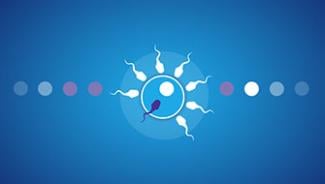Geriatric pregnancy or advanced maternal age: Let’s talk terminology

No matter your circumstance, being told your pregnancy is “geriatric” doesn’t feel great. If you’ve experienced this, you’re not alone. That said, many doctors and professionals now consider the term “geriatric pregnancy” outdated — here’s why.
In this article
- Why do age-related pregnancy stigmas exist?
- “Geriatric pregnancy” is now referred to as “advanced maternal age”
- What are potential benefits of advanced maternal age pregnancy?
- What potential risks of advanced maternal age pregnancy should I discuss with a doctor?
- How does being of advanced maternal age affect fertility?
- What should I expect when TTC at an advanced maternal age?
Why do age-related pregnancy stigmas exist?
Although it’s more common to have a baby in your 30s or early 40s compared to even just a few decades ago, social and cultural stigmas still exist.1 Often these stigmas are rooted in the reasons why a person may wait until they’re older to have a baby: better contraceptive methods, higher education goals, specific career goals, wanting to achieve higher socioeconomic status, workplace policies disadvantageous to working parents, unaffordable or limited childcare options, marrying at an older age, divorce and/or a later marriage, and/or fertility treatments.1
Additionally, because advanced maternal age increases the risk of pregnancy and maternal complications, it can cause inherent bias in medical care.1 A 2021 article in the “Journal of Women’s Health” discussed the importance of doctors thinking about how religion, culture, beliefs and behaviors may have created bias in pregnancy risk perception for those conceiving later in life. The article promoted “thoughtful messages of age diversity,”1 which is something, perhaps, we all can rally around.
“Geriatric pregnancy” is now referred to as “advanced maternal age”
Today the preferred term is “advanced maternal age” or “AMA” for short. Here we discuss what it means to be of advanced maternal age, including stigmas, risks, surprising benefits and things to be aware of for those who want to have a baby when they’re older.
Not only is “geriatric pregnancy” age more commonly referred to now as “advanced maternal age,” the number is up for discussion, too. As of 2022, the American College of Obstetricians and Gynecologists (ACOG) acknowledges that 35 years of age has been historically used as the threshold to determine AMA.2 ACOG goes on to say that “it should be noted that this is an arbitrary threshold,” and that “some risks associated with older age may not influence outcomes until later ages,” (such as 40 years or older).2 They report that instead of just putting AMA individuals into one category, recent studies now divide individuals into five-year increments (35 to 39, 40 to 44), which helps healthcare providers better recognize possible age-related risks more accurately.2
Also importantly, people are now having babies at older ages. The latest data from the 2020 U.S. National Vital Statistics Reports show a continued upward trend in the mean age of pregnant people in the U.S. Now nearly 19% of all pregnancies and 11% of first-time pregnancies occur in individuals 35 years or older. Also of interest: The mean age to have first births in 1970 was 21.4. In 2020, it was 27.1.3
Trends in women’s reproductive lifespans (between the first period and natural menopause) are changing, too. A 2021 study investigated 60-year trends in reproductive lifespans in U.S. women, and found that the mean reproductive lifespan increased by 2.1 years (from 35.0 to 37.1 years) over the interval between 1959-1962 and 2015-2018.4 The mean age at menarche declined from 13.5 years to 12.7 years, and the mean age of natural menopause increased from 48.4 years to 49.4 years, resulting in a potentially longer span of time within which an individual can get pregnant.4
What are potential benefits of advanced maternal age pregnancy?
While there are pros and cons of waiting to have children, you may be surprised by some of the benefits. Depending on your situation, waiting might mean you have more time (and money) to achieve a higher level of education. It’s also possible you may feel that with a few more years under your belt, you are more prepared financially, emotionally and situationally.
What potential risks of advanced maternal age pregnancy should I discuss with a doctor?
If you have any concerns about your potential pregnancy risks, speak with your doctor. According to the American College of Obstetricians and Gynecologists, advanced maternal age risks can include concerns about your health like gestational diabetes and preeclampsia as well as increased likelihood of a multiple pregnancy, early pregnancy loss or Down syndrome.2
Gestational diabetes
According to the latest National Vital Statistics Reports, in 2020 gestational diabetes affected the following percentage of people by age:
- 2.5% under age 20
- 4.5% ages 20 to 24
- 6.6% ages 25 to 29
- 8.8% ages 30 to 34
- 11.7% ages 35 to 39
- 15.3% ages 40 and over5
Preeclampsia
According to a study by the ACOG, the risk of preeclampsia increased 30% in those 40 to 44 years old, and more than doubled for those 45 to 59 years old.2
Multiple pregnancy
In 2018, 17.1 out of every 1,000 births in individuals younger than 20 were twins. That number jumped to 51.1 out of every 1,000 births in individuals 40 to 54 years.2 According to ACOG, “Some of the increased risk for multiple gestation is likely due to increased use of ovulation induction and assisted reproductive technology; however, the proportion of twin pregnancies that result from assisted reproductive technology is not delineated in vital statistics data.”2
Early pregnancy loss
The ACOG recommends those older than 35 talk to their doctor after six months of failing to conceive, in part due to an increased risk of pregnancy loss.6 Using data from those who conceived via IVF, ACOG states that miscarriage progressively increases with age as follows:
- At ages 33 to 34 years, the occurrence of miscarriage is 11.4% after seven weeks with fetal heart activity observed via transvaginal ultrasonography.
- At ages 35 to 37 years, it’s 13.7%.
- At ages 38 to 40 years, it’s 19.8%.
- At ages 41 to 42 years, it’s 29.9%.
- At over 42 years, it’s 36.6%.6
Down syndrome
Down syndrome is one of the most common chromosomal disorders in infants.7 As you age, the risk of your baby having a missing, damaged or extra chromosome increases.8 According to the ACOG, the risk of having a pregnancy affected by Down syndrome increases with age as follows:
- At age 20, the risk is 1 in 1,250
- At age 25, the risk is 1 in 1,000
- At age 30, it’s 1 in 714
- At age 35, it’s 1 in 294
- At age 40, it’s 1 in 868
(Note, however, that according to the Centers for Disease Control and Prevention, the majority of babies born with Down syndrome are born to mothers younger than 35 years old, because more births occur at younger ages.7)
How does being of advanced maternal age affect fertility?
If you are of AMA, the No. 1 factor to consider when trying to conceive (TTC) is fertility. According to the ACOG, when you’re healthy and in your 20s and 30s, your chances of getting pregnant in any single cycle are one in four. By age 40, those chances become one in 10 and by age 45, getting pregnant is unlikely.8 This happens for a couple of reasons. You begin your life with a set amount of eggs (about 1 to 2 million).6 As you age, the overall quantity of eggs declines to about 25,000 by age 37 and 1,000 at age 51,6 and the likelihood of your eggs having abnormal chromosomes increases.8 You’re also at a higher risk for endometriosis, which can affect fertility as you age.6 It’s also important to remember that perimenopause tends to start in your 40s leading up to menopause — when it will no longer be possible to get pregnant.
What should I expect when TTC at an advanced maternal age?
If you’re 35 years or older and want to have a baby, talk to your ob-gyn or a healthcare provider before trying to conceive. They can help you come up with a highly personalized plan to optimize your health as much as possible before trying to get pregnant.9
Once you have a positive pregnancy test result, contact your doctor. Depending on your age, they may want to see you in-office sooner. If you are of AMA, they will also likely talk to you about prenatal screening and diagnostic tests. Here’s a quick lesson in how these differ:
- Prenatal screening tests assess risks and can be done before or during pregnancy. They look at the chance that the pregnancy will be affected by a birth defect or genetic disorder.8
- Prenatal diagnostic tests detect if a pregnancy is affected by a birth defect or genetic disorder and can only be done during pregnancy. That’s because they detect if the pregnancy is, indeed, affected by a specific birth defect or disorder.8
Your doctor will advise on any prenatal tests needed based on your personal history and circumstances.
If you’re of AMA, know this: It’s a whole different world compared to several generations ago. We have certainly seen a cultural and societal shift when it comes to age and pregnancy, and more resources than ever exist to help you have the best experience possible.
Related Articles
Sources :
- Correa-de-Araujo R, Yoon SS. Clinical outcomes in high-risk pregnancies due to advanced maternal age. J Womens Health (Larchmt). 2021;30(2):160-167. doi: 10.1089/jwh.2020.8860. Accessed January 31, 2023 https://www.ncbi.nlm.nih.gov/pmc/articles/PMC8020515/
- The American College of Obstetricians and Gynecologists. Obstetric care consensus No. 35: pregnancy at age 35 years or older. Updated August 2022. Accessed January 31, 2023. https://www.acog.org/clinical/clinical-guidance/obstetric-care-consensus/articles/2022/08/pregnancy-at-age-35-years-or-older
- Osterman MJK, Hamilton BE, Martin JA, Driscoll AK, Valenzuela CP. Births: final data for 2020. NVSR. 2022;70(17). doi: 10.15620/cdc:112078. Accessed January 31, 2023. https://stacks.cdc.gov/view/cdc/112078
- Appiah D, Nwabuo CC, Ebong IA, Wellons MF, Winters SJ. Trends in age at natural menopause and reproductive life span among US women, 1959-2018. JAMA. 2021;325(13):1328-1330. doi: 10.1001/jama.2021.0278. Accessed January 31, 2023. https://jamanetwork.com/journals/jama/article-abstract/2778126
- Gregory EC, Ely DM. Trends and characteristics in gestational diabetes: United States, 2016-2020. Natl Vital Stat Rep. 2022;71(3):1-15. Accessed January 31, 2023. https://www.cdc.gov/nchs/data/nvsr/nvsr71/nvsr71-03.pdf
- The American College of Obstetricians and Gynecologists. Committee opinion: female age-related fertility decline. Updated 2022. Accessed January 31, 2023. https://www.acog.org/clinical/clinical-guidance/committee-opinion/articles/2014/03/female-age-related-fertility-decline
- Centers for Disease Control and Prevention. Facts about Down syndrome. Updated November 18, 2022. Accessed January 31, 2023. https://www.cdc.gov/ncbddd/birthdefects/downsyndrome.html
- The American College of Obstetricians and Gynecologists. Having a baby after age 35: how aging affects fertility and pregnancy. Updated February 2023. Accessed March 28, 2023. https://www.acog.org/womens-health/faqs/having-a-baby-after-age-35-how-aging-affects-fertility-and-pregnancy
- Glick I, Kadish E, Rottenstreich M. Management of pregnancy in women of advanced maternal age: improving outcomes for mother and baby. Int J Womens Health. 2021;13:751-759. doi: 10.2147/IJWH.S283216. Accessed January 31, 2023. https://www.ncbi.nlm.nih.gov/pmc/articles/PMC8364335/

Can I get pregnant if I'm over 35?
If you’re over 35 you may need a little more patience and greater understanding about your fertility window to help you have a baby naturally.

Get pregnant naturally
Ovulation tests are accurate and simple to use.




